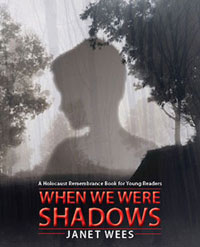| ________________
CM . . .
. Volume XXIV Number 11. . . .November 17, 2017

 |
When We Were Shadows. (A Holocaust Remembrance Book for Young Readers).
Janet Wees.
Toronto, ON: Second Story Press, April, 2018.
200 pp., trade pbk., $14.95.
ISBN 978-1-77260-061-2.
Grades 5-8 / Ages 10-13.
Review by Carmelita Cechetto-Shea.
***1/2 /4
Reviewed from Advance Reading Copy.
|
| |
|

excerpt:
A lump formed in my stomach and remained there. I called it the lump of longing; longing for the hugs we used to share; longing for my oma, longing to feel safe, longing for an end to the war, longing to grow up so I could do something. I'd go to sleep with a plan to dream about the good times in Den Haag, but many times I'd wake up sweating and scared.
Helplessness cloaked me. I drew pictures of darkness, shadows, and explosions.
Janet Wees' When We Were Shadows is the most recent title in the award-winning series "A Holocaust Remembrance Book for Young Readers". This series provides a great educational tool for young people to learn about the Holocaust which is always a serious issue to discuss. When We Were Shadows is the true story of a young Jewish boy named Walter and his family who, because of the Nazi regime, fled Germany to start life anew in the Netherlands. Ironically, the Netherlands also falls prey to the Nazis, and Walter realizes he still isn't safe.
Throughout the story, as a young boy Walter writes letters to his Oma in Germany, and these letters provide insight into Walter's world, his thoughts, feelings and his fears. Near the end of the book, the adult Walter writes a letter to his granddaughter Jenny. Scattered throughout are other letters Walter writes to his friend Alfred (a German deserter) and to a friend of his father's (Mr. von Baumhauer). These letters also provide information about what Walter's life is like during all the hiding during the war. Readers also are provided with insight into the Dutch Resistance movement and their acts of bravery and courage to help Jewish people survive. During World War II, Edourd Henri von Baumhauer and his wife played an important role in the work of the Dutch Resistance. Walter talks about the Hidden Village, known as Verhouton, which was founded by the von Baumhauers and which grew to over 100 Jews who were in hiding deep in the dense forests of the Netherlands. The book's spanning Walter's life from the ages of 6 to 14 allows the reader to see the turmoil and fear through the eyes of a child. Walter's naivety often makes the danger and fear seem like a big adventure, but, as time goes by, Walter begins to realize the seriousness of what is happening around him.
A question that always creates much discussion and debate is: "How do you explain the Holocaust to a child?" Introducing children to such a horrific topic is often difficult, and a gentle approach is often a good way to introduce the topic without inflicting the details of what humans do to other humans. Instead of dwelling on the atrocities of the Holocaust, experts recommend the introduction of books on acceptance, courage, and loyalty, exactly what transpires in the When We Were Shadows. Written in the language appropriate for the intended readers (ages 10-13), Wees has shared a true story of a young boy dealing with life at an adult level, trying to remain a boy, but realizing that his youth is no longer typical and carefree. It is clearly written and designed to be used as an educational tool for children; there is also a teacher's guide for the series available online. When We Were Shadows is a perfect choice for school libraries, whether as a stand-alone read or as a curriculum resource for teachers. When We Were Shadows will inform readers, young and old, on the journey of a young boy during the Holocaust, but ultimately it will inspire all to discover how the human spirit can triumph over evil.
Highly Recommended.
Carmelita Cechetto-Shea is the Library Consultant for the Cape Breton-Victoria Regional School Board, Sydney, NS.

© CM Association
CC BY-NC-ND
Hosted by:
University of Manitoba
ISSN 1201-9364
|
This Creative Commons license allows you to download the review and share it with others as long as you credit the CM Association. You cannot change the review in any way or use it commercially.
Commercial use is available through a contract with the CM Association. This Creative Commons license allows publishers whose works are being reviewed to download and share said CM reviews provided you credit the CM Association. |
Next Review | Table of Contents for This Issue - November 17, 2017.
CM Home | Back Issues | Search | CM Archive | Profiles Archive
|
